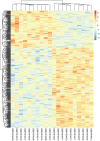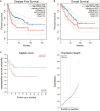Comprehensive Analysis of Aerobic Exercise-Related Genes Identifies CDCA4 That Promotes the Progression of Osteosarcoma
- PMID: 33613651
- PMCID: PMC7886999
- DOI: 10.3389/fgene.2021.637755
Comprehensive Analysis of Aerobic Exercise-Related Genes Identifies CDCA4 That Promotes the Progression of Osteosarcoma
Abstract
Background: Exercise has a positive impact on patients with osteosarcoma, improving function, reducing disability, maintaining independence and quality of life. Exercise may also directly affect the effectiveness of cancer treatment. Cell division cycle-associated protein 4 (CDCA4) is reported to function importantly during numerous human cancers development. Nevertheless, the details toward CDCA4 function are still to be investigated.
Methods: This study comprehensively analyzed the GSE74194 database and obtained aerobic exercise-related genes. Protein-protein interaction network (PPI) and Gene Ontology (GO) analysis were performed on the differentially expressed genes (DEGs). Quantitative reverse transcription polymerase chain reaction (qRT-PCR) and tumor genome atlas (TCGA) data mining were applied to measure aerobic exercise-related gene CDCA4 level in osteosarcoma tissue. We conducted lots of functional experiments to uncover CDCA4 function and its corresponding mechanism in osteosarcoma.
Results: We screened a total of 547 DEGs related to aerobic exercise, of which 373 were up-regulated and 174 were down-regulated. PPI analysis revealed 90 genes that might play key roles. GO analysis showed that aerobic exercise-related DEGs were significantly enriched during the mitotic cell cycle, cell division, mitotic nuclear division and sister chromatid segregation, nuclear division, microtubule cytoskeleton organization involved protein, microtubule-based process, spindle organization, G2/M transition of mitotic cell cycle. Our results indicated that CDCA4 was increased in osteosarcoma tissues and cell lines, and its level had association with high mortality of osteosarcoma patients. Further studies revealed that absence of CDCA4 largely hindered osteosarcoma cancer cell proliferation, invasion, and migration.
Conclusion: Comprehensive bioinformatics analysis improves our understanding of the underlying molecular mechanisms of aerobic exercise on osteosarcoma. This provides evidence for the effect of aerobic exercise on CDCA4 expression. Our data suggested that CDCA4 could facilitate osteosarcoma development, and gave a hint that CDCA4 was a candidate target in the treatment of osteosarcoma, aerobic exercise might help the treatment and prognosis of patients with osteosarcoma.
Keywords: CDCA4; aerobic exercise; comprehensive analysis; osteosarcoma; progression.
Copyright © 2021 Hao, Zhu, Zhang, Qiu, Xuan and Ye.
Conflict of interest statement
SH was employed by the company Shuangwu Information Technical Company Ltd. The remaining authors declare that the research was conducted in the absence of any commercial or financial relationships that could be construed as a potential conflict of interest.
Figures








Similar articles
-
Circ_0010220-mediated miR-503-5p/CDCA4 axis contributes to osteosarcoma progression tumorigenesis.Gene. 2020 Dec 30;763:145068. doi: 10.1016/j.gene.2020.145068. Epub 2020 Aug 19. Gene. 2020. PMID: 32827680
-
A Pan-Cancer Analysis of the Oncogenic Role of Cell Division Cycle-Associated Protein 4 (CDCA4) in Human Tumors.Front Immunol. 2022 Feb 17;13:826337. doi: 10.3389/fimmu.2022.826337. eCollection 2022. Front Immunol. 2022. PMID: 35251007 Free PMC article.
-
The spindle function of CDCA4.Cell Motil Cytoskeleton. 2008 Jul;65(7):581-93. doi: 10.1002/cm.20286. Cell Motil Cytoskeleton. 2008. PMID: 18498124
-
ELK1-induced upregulation lncRNA LINC02381 accelerates the osteosarcoma tumorigenesis through targeting CDCA4 via sponging miR-503-5p.Biochem Biophys Res Commun. 2021 Apr 9;548:112-119. doi: 10.1016/j.bbrc.2021.02.072. Epub 2021 Feb 25. Biochem Biophys Res Commun. 2021. PMID: 33640603
-
CENPE, PRC1, TTK, and PLK4 May Play Crucial Roles in the Osteosarcoma Progression.Technol Cancer Res Treat. 2020 Jan-Dec;19:1533033820973278. doi: 10.1177/1533033820973278. Technol Cancer Res Treat. 2020. PMID: 33176597 Free PMC article.
Cited by
-
Methylation and Expression of the Exercise-Related TLR1 Gene Is Associated With Low Grade Glioma Prognosis and Outcome.Front Mol Biosci. 2021 Nov 16;8:747933. doi: 10.3389/fmolb.2021.747933. eCollection 2021. Front Mol Biosci. 2021. PMID: 34869584 Free PMC article.
-
CDCA4 interacts with IGF2BP1 to regulate lung adenocarcinoma proliferation via the PI3K/AKT pathway.Thorac Cancer. 2023 Mar;14(8):724-735. doi: 10.1111/1759-7714.14800. Epub 2023 Feb 3. Thorac Cancer. 2023. PMID: 36737405 Free PMC article.
-
TRIM4 Expression Related to Malignant Progression and Cisplatin Resistance in Osteosarcoma.Appl Biochem Biotechnol. 2024 Jan;196(1):233-244. doi: 10.1007/s12010-023-04551-5. Epub 2023 Apr 28. Appl Biochem Biotechnol. 2024. PMID: 37115387
-
The Impact and Molecular Mechanisms of Exercise in Cancer Therapy.Curr Issues Mol Biol. 2025 May 20;47(5):374. doi: 10.3390/cimb47050374. Curr Issues Mol Biol. 2025. PMID: 40699773 Free PMC article. Review.
-
The Higher Expression of CDCA2 Associated with Poor Prognosis in Glioma.Dis Markers. 2022 Mar 27;2022:2184867. doi: 10.1155/2022/2184867. eCollection 2022. Dis Markers. 2022. Retraction in: Dis Markers. 2023 Jul 19;2023:9781753. doi: 10.1155/2023/9781753. PMID: 35386230 Free PMC article. Retracted.
References
-
- Ashcraft K. A., Peace R. M., Betof A. S., Dewhirst M. W., Jones L. W. (2016). Efficacy and mechanisms of aerobic exercise on cancer initiation, progression, and metastasis: a critical systematic review of In Vivo preclinical data. Cancer Res. 76 4032–4050. 10.1158/0008-5472.can-16-0887 - DOI - PMC - PubMed
LinkOut - more resources
Full Text Sources
Other Literature Sources

